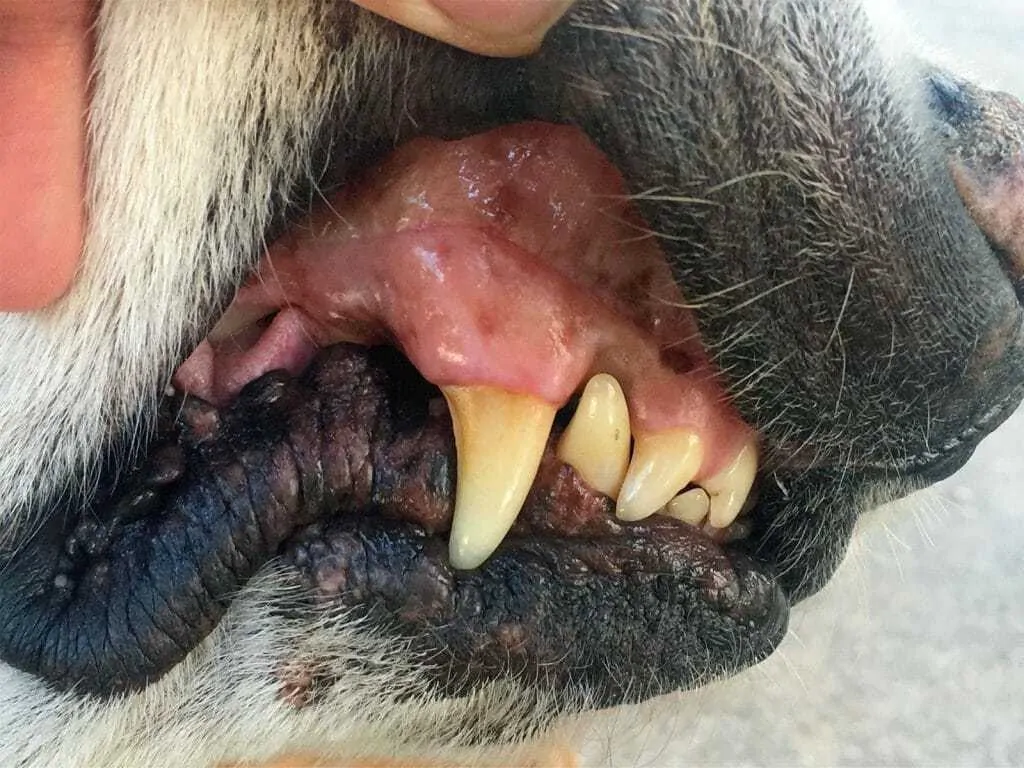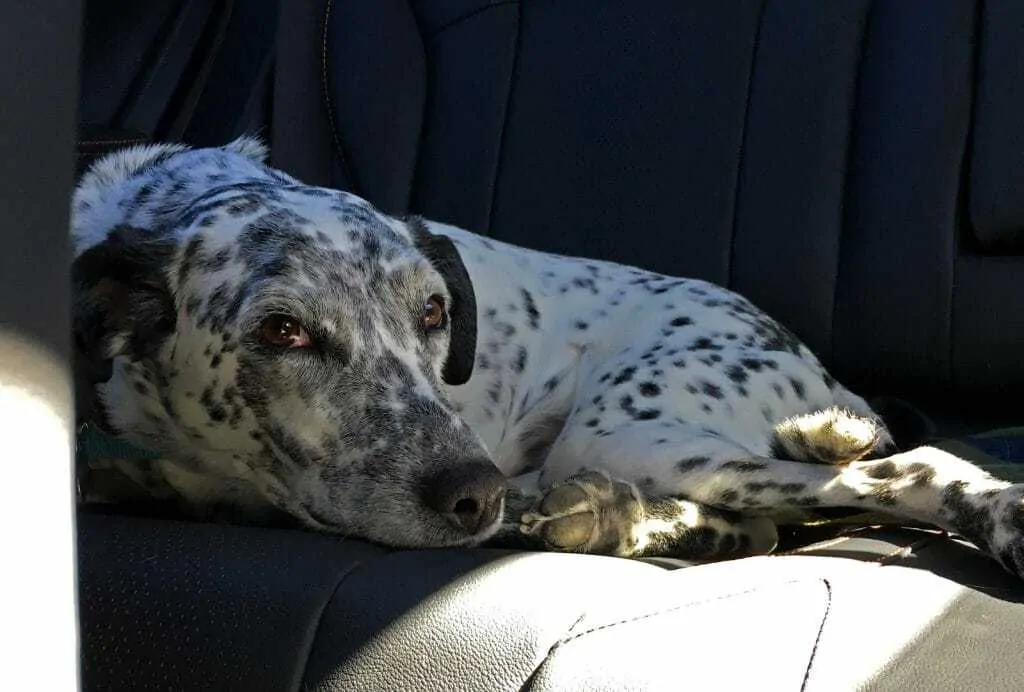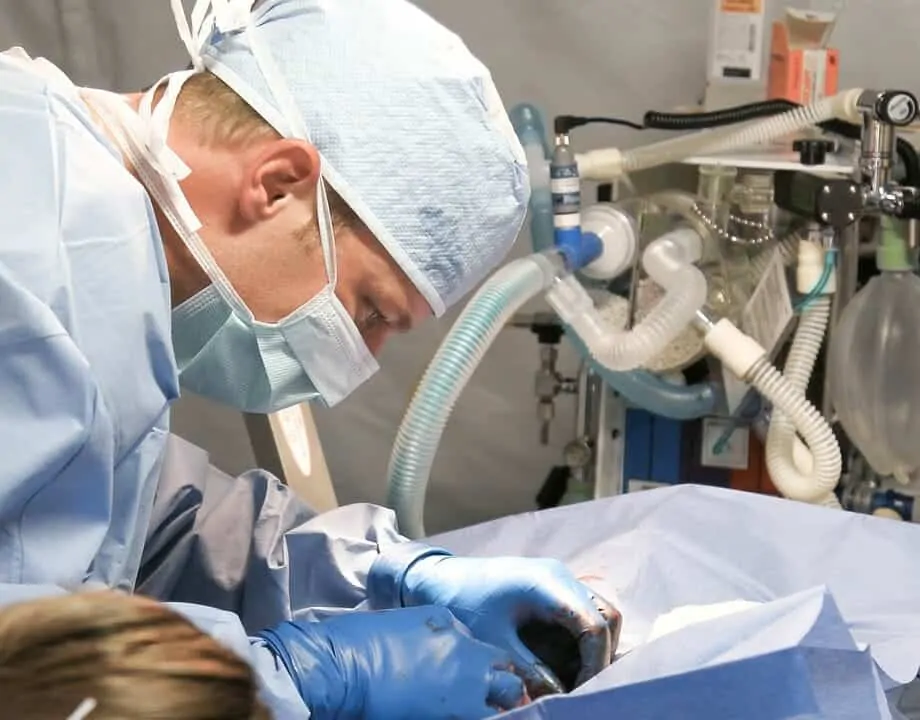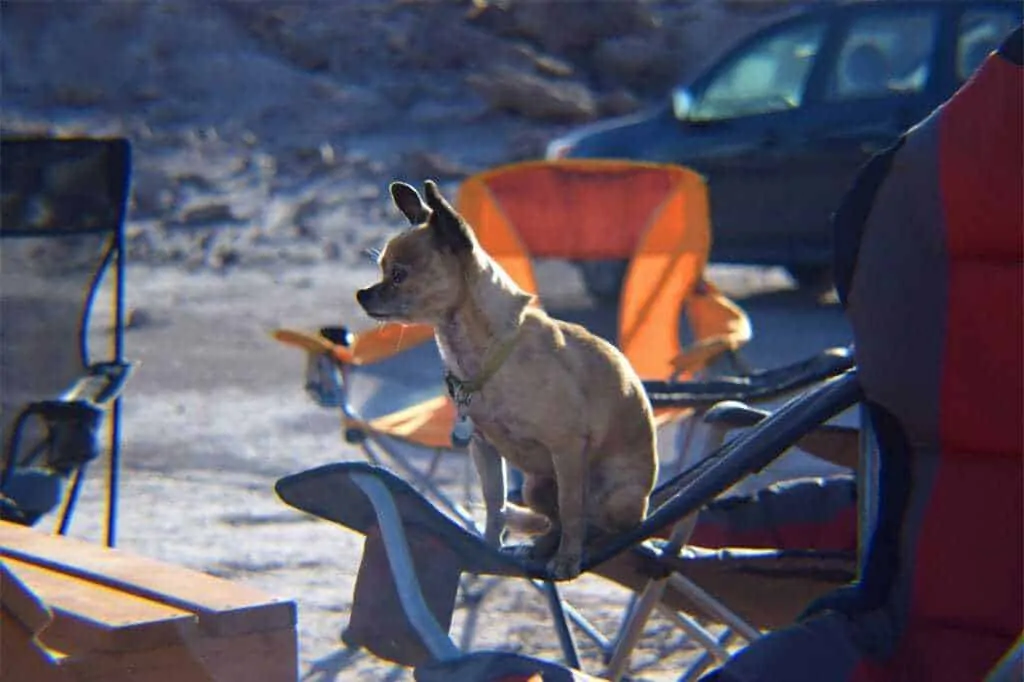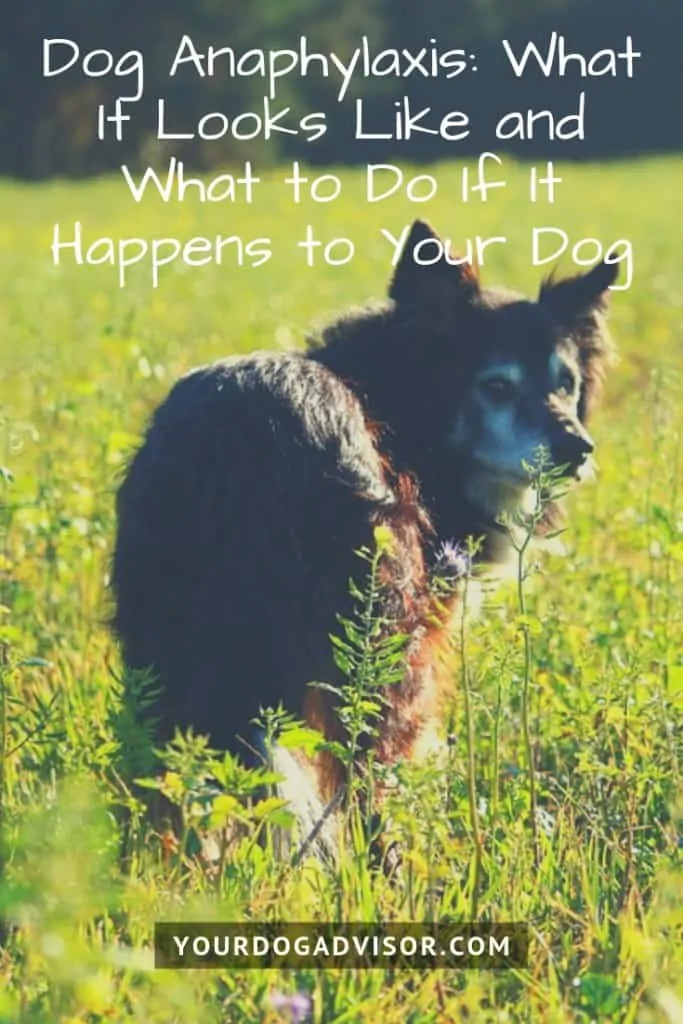If you’ve ever experienced a situation involving anaphylaxis, you know how terrifying it can be. Whether the victim is a dog or a human, the situation can turn deadly in the blink of an eye.
Anaphylaxis can strike anywhere from a field full of buzzing bees to dinner time in the house. Knowing what your dog is allergic to is the first step in preventing life-threatening allergic reactions.
When my dog started acting strange one day, anaphylaxis was the last thing on my mind. She was just very suddenly “not herself.” Her head and tail hung low. She seemed stiff and lifeless even as she slowly walked toward my calls.
I had no idea what was wrong with her. Had she hurt herself? Was she bloating? There weren’t any obvious signs of injury or even of pain.
But there was clearly something wrong.
If I hadn’t been trained in dog first aid, I likely would have spent a significant amount of time trying to figure out what had happened to my dog. And by the time I figured it out (or not), it may have been too late.
Luckily, I knew one of the first things to check when a dog appears suddenly ill, is their gums. I lifted my dog’s lips and immediately saw the tell-tale gray, tacky flesh that told me something was seriously wrong. I still didn’t know she was suffering from a severe allergic reaction, but I did know pale gums was a sign of shock. And that shock requires immediate medical intervention.
Over the next six hours, I would learn a lot more about anaphylaxis than I ever knew before.
Contents
What Is Anaphylaxis
If you or someone you know has ever suffered from severe allergies, such as to peanuts, you likely have some idea of what anaphylactic shock is. If you’re lucky enough to have never experienced it, however, it’s a good idea to learn what it is and how to spot it.
Anaphylaxis occurs when the body’s immune system produces a substance called immunoglobin E. This substance binds to cells in the body called mast cells that then release chemicals that cause an allergic reaction, such as redness, swelling, or hives.
Even something as small as the bite from a venomous ant can trigger an allergic reaction if your dog has become sensitive to their venom.
After this process occurs once, it is likely to get more severe with each additional exposure. If a bee sting causes a welt on your dog the first time it happens, it may cause full-body hives the next.
In severe cases, repeated exposure will result in localized mast cell reactions triggering reactions throughout the body. This leads to a full anaphylactic reaction.
It is possible for a human or dog to develop anaphylaxis the very first time they are exposed to something. These reactions occur through slightly different pathways and are far less common.
How Do Anaphylactic Reactions Differ in Dogs
Many people associate anaphylaxis with not being able to breathe. In humans, these kinds of severe allergic reactions do often show themselves with the swelling of the face, throat, and bronchi in the lungs.
Unlike humans and many other domestic animals, anaphylaxis in dogs usually affects the liver before any other organ. Blood flow to the liver is obstructed by an influx of histamine from the intestines. This disruption also affects blood flow to the heart, which causes hypovolemic shock.
Wasp stings and bites are common causes of severe allergic reactions in both people and dogs.
Swelling of the face and difficulty breathing can occur if a dog was stung near the mouth or nose. But, breathing problems are a much less common symptom in dogs experiencing a severe allergic reaction.
>>>Allergic reactions aren’t the only health problems that require an emergency trip to the vet. Learn how to identify the symptoms of pancreatitis in your dog.
Common Triggers for Anaphylaxis
Allergic reactions occur most frequently in response to foreign proteins entering the system, but just about anything can cause a reaction.
The most common allergens for dogs that can lead to anaphylaxis are:
- Insect bites or stings
- Vaccinations
- Medications
- Proteins in foods
- Chemicals
- Pollutants
Blood transfusions, contrast dyes, and certain kinds of chemotherapy are also known to cause anaphylaxis in rare cases.
Even something as simple as a little snack can turn deadly if your dog is allergic to any of the ingredients.
>>>Bee stings aren’t the only thing that your dog should worry about when outside. Find out what happened when this canine encountered a moose in her backyard.
How to Recognize Anaphylaxis in Your Dog
Because anaphylaxis in dogs affects the liver and not usually the lungs, this type of reaction looks much different in dogs than humans. It is important to recognize the symptoms of a severe allergic reaction because treatment needs to be started as quickly as possible.
Some dogs, like mine, will have such rapid and severe reactions that they will not show any of the initial signs (listed first) and will only present with the more severe symptoms.
Red patchy skin and swelling
One of the very first signs that your dog is experiencing an allergic reaction is red, irritated skin. This may be localized to where contact was made with the specific substance, or where your dog was bitten or stung. Swelling is also common around stings and may be slight or severe.
For many dogs, this symptom won’t progress into a full anaphylactic reaction. But for those that do experience this unfortunate situation, the initial redness or swelling may go away before more serious symptoms take hold.
Swelling of the face and muzzle is common when dogs are stung in the mouth by a wasp or bee.
Hives
Like swelling and redness, hives are often one of the first signs your dog is having an allergic reaction to something. This could be something they ate or something they came into contact with. For dogs having a life-threatening reaction, this symptom is likely to be short-lived as more severe symptoms begin.
Nausea, vomiting, or diarrhea
Because histamine is released from the intestines during anaphylaxis in dogs, it shouldn’t be surprising that many of the symptoms relate to the gut. Your dog may vomit up a recent meal or puddles of clear mucus. They may also experience sudden diarrhea.
When my dog came into the house through the dog door, the first symptom I noticed was her odd, stiff gate. I think this was likely because she was feeling nauseous. While she was at the hospital, I walked around our backyard and found a small spot of vomit as well.
Take some time to study the color of your dog’s gums as well as how long it takes them to pink back up when pushed on. Recognizing changes in gum color and capillary refill can help you identify a problem before its too late.
Pale gums
Because blood flow is restricted during anaphylaxis, you will notice your dogs gums, lips, and other mucous membranes are very pale and tacky. If you press on your dog’s gums you will likely notice that the white spot from the indent takes longer than normal to refill with blood. This is another sign your dog’s blood pressure has dropped.
If your dog is showing these symptoms, they are definitely experiencing a medical emergency and need professional help right away.
Cold limbs
Another side effect of decreased blood pressure and blood being rerouted to major organs is restricted blood flow in the limbs. You may notice your dog’s paws are cooler than normal. You may also struggle to find a pulse in their legs and their heartbeat in their chest may be faint.
Behaviors changes, lethargy, or collapse
One of the most distressing symptoms my dog showed was a very dramatic and sudden change in behavior. One minute we were playing fetch. The next, she was walking into the house as if someone had just beaten her. She wouldn’t lift her head or wag her tail.
You may also notice your dog having trouble walking straight as blood flow to the brain lessens. They may refuse to stand up or collapse and lose consciousness. In a situation like this, starting CPR may be warranted.
Dogs experiencing severe allergic reactions or those in the late stages of shock may collapse or fall unconscious.
Breathing problems
Some dogs will show signs of difficulty breathing. They may cough, gasp, or wheeze. This is most likely to happen when accompanied by swelling in the face, muzzle, or tongue. Dogs with insect sting or bite allergies are more at risk for breathing problems because they often bite bugs out of the air. This can result in being stung in the mouth or throat.
What to Do If Your Dog Is In Anaphylactic Shock
Knowing the symptoms of anaphylaxis is just the first step to saving your dog. Once you recognize the possible signs of a severe allergic reaction, you need to react as quickly as possible.
Left untreated, anaphylaxis is almost always fatal. Even the most prepared and experienced owners will still need to get to their dog to a vet to be stabilized and to prevent the sudden return of symptoms known as biphasic reactions.
Look For the Insect Stinger
If there is any possibility your dog’s reaction was caused by an insect sting, a quick once-over to find the stinger is worth a moment of your time. So long as your dog is stable, quickly check them for red spots or swelling. If you can find the stinger, you need to remove it immediately by scraping it with a credit card or fingernail.
Do not squeeze the stinger with your fingers or tweezers, as this will likely result in more venom being forced into your dog’s body.
<iframe width=”560″ height=”315″ src=”https://www.youtube.com/embed/aboc7xbzdtU” frameborder=”0″ allow=”accelerometer; autoplay; encrypted-media; gyroscope; picture-in-picture” allowfullscreen></iframe>
Removing a stinger the right way will prevent extra venom from being injected into your dog.
If there are no obvious red or swollen areas, then move on to the next step. You do not want to waste more than a minute looking for a stinger, especially if there are no obvious signs that one exists.
Contact the Closest Vet
Getting your dog to the vet as soon as possible is the best thing you can do in order to save their life. If you have an emergency vet nearby, then I suggest loading your dog into the car and calling them while you’re on your way. Make sure to mention that you believe your dog is suffering from a severe allergic reaction. They will have specific treatments ready for your arrival that will save vital time.
Wrapping a dog in a blanket when they are in shock can help fight hypothermia as blood leaves the limbs and pools in the abdomen.
If you do not have an emergency vet nearby, find the closest open facility and let them know you are coming. Calling ahead will prevent you from showing up at a closed office or one that is unable to treat your dog.
In almost all cases, vets will inject your dog with epinephrine to raise their blood pressure and reduce the reaction. Most vet offices will have this drug available. Even if they are unable to fully treat your pup, they should be able to help stabilize them so they can be safely moved to another hospital.
>>>Allergic reactions aren’t the only medical emergencies my dogs have put me through. Find out what to do when a dog ingests rat poison.
Give Over-the-Counter Antihistamine
If you call ahead, your vet may recommend you give your dog an over the counter antihistamine before transporting them. The most common medication that is safe for dogs is Benedryl. Giving this before heading to the vet may buy you some time or reduce the reaction enough to keep your dog stable.
The typical dose for Benedryl is one mg per pound of body weight. Do not try to give your dog a pill if they are unconscious or struggling to breathe.
Because dogs’ intestines are the first organ affected by anaphylaxis, your dog may not be able to digest the pill fast enough for it to have an effect. Your best bet is to get your dog to the vet as soon as possible. But, if you are far from the nearest hospital, crushing up a dose of antihistamines and rubbing it on your dog’s gums may help slow the reaction enough to get them to the vet.
>>>Ever hear of using Benedryl to calm your dog down? Take a look at our list of the best calming supplements for a more effective remedy of nervous pups.
Check Your Dog’s Condition Before Transport
If your dog is stable (able to stand, breath without difficulty), it’s time to shove them in the back of the car and head to the vet. But, if they are too weak to stand, unconscious, or struggling to breathe, you need to take a moment to get them positioned first.
Transporting your dog to the vet in the middle of an anaphylactic episode is a stressful thing, but a must so they can receive life-saving treatment.
For dogs that can’t stand or are unconscious, lay them on their side in the back of the car. Elevate their legs slightly with a pillow or rolled up blanket. This will help keep blood flowing to the major organs. Cover them with a blanket is possible to keep their body temperature up.
If your dog is struggling to breathe, you need to get to the vet as fast as possible. But, if they lose consciousness or stop breathing, you may need to perform CPR. In a perfect world, you will have someone with you who can care for the dog while you drive. If not, you will have to make the tough decision to pull over and help your dog or to keep driving. Base this decision off of your personal knowledge of pet first aid and how far away you are from the vet.
What to Expect at the Vet
Congratulations, you’ve made it to the vet! You’ve just increased your dog’s chance of survival exponentially.
Depending on your dog’s status when they arrive at the vet, they may need to be intubated to help them breathe.
Once you arrive, a team of vets will most likely whisk your dog away for emergency treatment. This will include things like epinephrine and antihistamine drugs to reduce the allergic reaction. They will also likely receive an IV to help treat shock and drugs to stabilize blood pressure.
If your dog is having trouble breathing or has lost consciousness, they will also likely put a tube in their throat to keep the airway open.
When we arrived at the vet with my dog that fateful day, we had no idea she was suffering from anaphylaxis. But the vets took one look at her pale gums and rushed her into the back. They were able to stabilize her with IVs and blood pressure meds while they tried to determine the cause. Once poisoning and physical trauma were ruled out, she was put on epinephrine and antihistamines. A couple of hours later she developed full body hives. While this was horrible to see, it was a positive sign that the original cause of the problem was in fact anaphylaxis.
Your vet may need to keep your dog for 24 to 36 hours depending on how they react to treatment. As many dogs develop secondary reactions after initially stabilizing, allowing your dog to stay at the vet is the safest choice.
Once your dog is discharged, your vet may prescribe daily antihistamines for the next week or so to avoid additional biphasic reactions.
How to Protect Your Dog From Repeat Anaphylactic Episodes
Every time a dog is exposed to an allergen, their reaction is likely to get worse. If your dog has already suffered a severe anaphylactic reaction to something, their next exposure is likely to progress even faster and may not respond as well to treatment.
Keeping your dog safe from items they are allergic too isn’t always easy. Dogs who are allergic to insects or other environmental allergens will need special considerations during travel, camping, and other outdoor activities.
How you avoid your dog being exposed to the allergen in the future will depend on what they are allergic to. For food allergies, you will need to treat your dog much like a child with a peanut allergy. Read all dog food labels, and never let anyone give your dog a treat unless you know what’s in it.
If your dog reacted to a chemical, toxin, or vaccination, you’ll need to prevent reexposure in the future as much as possible. Your vet may excuse you from repeated vaccinations or use preventative drugs before the vaccination is given to lessen reactions.
For dogs with insect allergies, preventing reexposure is much more difficult. We believe our dog was stung by a wasp that day (though we aren’t one-hundred percent sure). Now, we take precautions to reduce the chance it happens again. During the summer, we only let her outside when we are home. We have also tried to teach her not to snap at bugs and have taken steps to repel wasps from our yard using fake nests and offending scents.
>>>Need to keep your pet indoors? Here’s a list of ways to exercise your pup without going for walks.
Our vet also recommended we use a daily dose of Benedryl in the summer. The idea is that this would lessen the initial reaction if she were to get stung and buy us time to get to the vet. She couldn’t say for sure, however, if this tactic would actually work. But, anytime we are far from vet intervention, such as during camping and hiking trips, we always dose her with Benedryl and bring extra should she get stung.
Some owners may choose to add an EpiPen to their dog’s first aid kit. Just like with humans, these pens can stop or slow anaphylaxis when given after exposure to allergens. Unfortunately, you have to pay out-of-pocket pricing for them and they aren’t cheap. Our vet was nice enough to give us a vile of two doses of epinephrine and a syringe to carry with us for our dog. Talk to your vet about this option.
You’ll also want to make sure anyone watching your dog, such as boarding kennels and pet sitters, know about their allergies and what to watch for.
In the end, you can only do so much to prevent your dog from experiencing an anaphylactic reaction. But knowing how to recognize the signs, and what to do if it happens can make all the difference for your canine friend.
Caring for a dog with extreme allergies can be stressful, but understanding how to react during anaphylactic events can help them live a long and happy life.

Sara Seitz has spent most of her life in the pet industry and has a bachelors in animal behavior from Colorado State University. Sara started working with dogs and cats as a high schooler at a rural boarding kennel. There she learned a lot about the bad and the ugly of the pet service industry. But not even the toughest day at that job would dissuade Sara from following her dream of working with animals.
In college, Sara got a job at a dog daycare and boarding facility in Fort Collins, Colorado. Her new career provided even more opportunities for learning about dog behavior than her classes did. As general manager of the daycare, Sara helped the company launch a new in-home pet sitting branch and trained to become a certified dog trainer. Between shifts taking care of peoples pets in-home and supervising dogs during playtime at the daycare, Sara organized and taught obedience classes.
Sara has always been passionate about bettering the lives of our canine companions. She soon found that advocating for and educating owners in the power of positive reinforcement training was one of the best ways to help dogs and their owners live happier lives.





